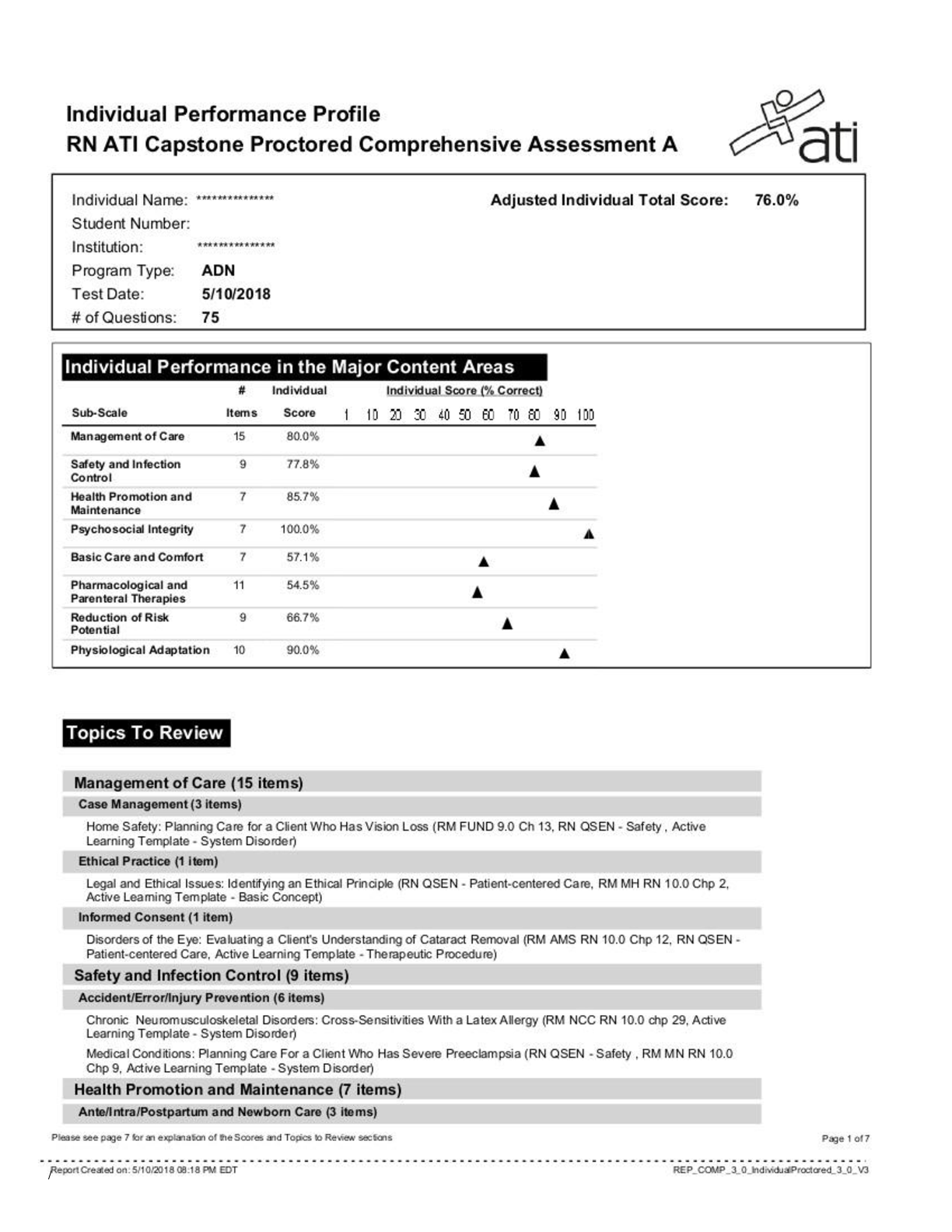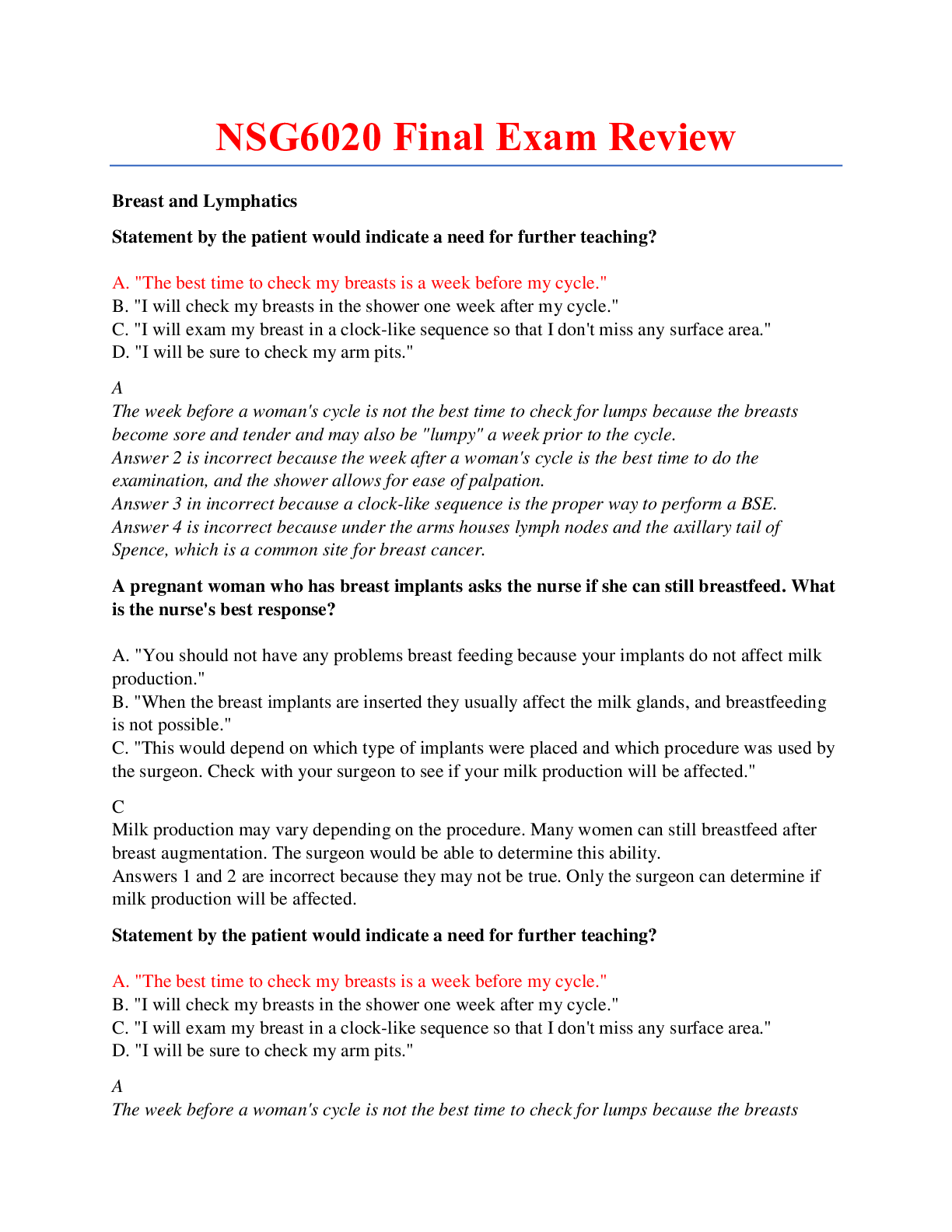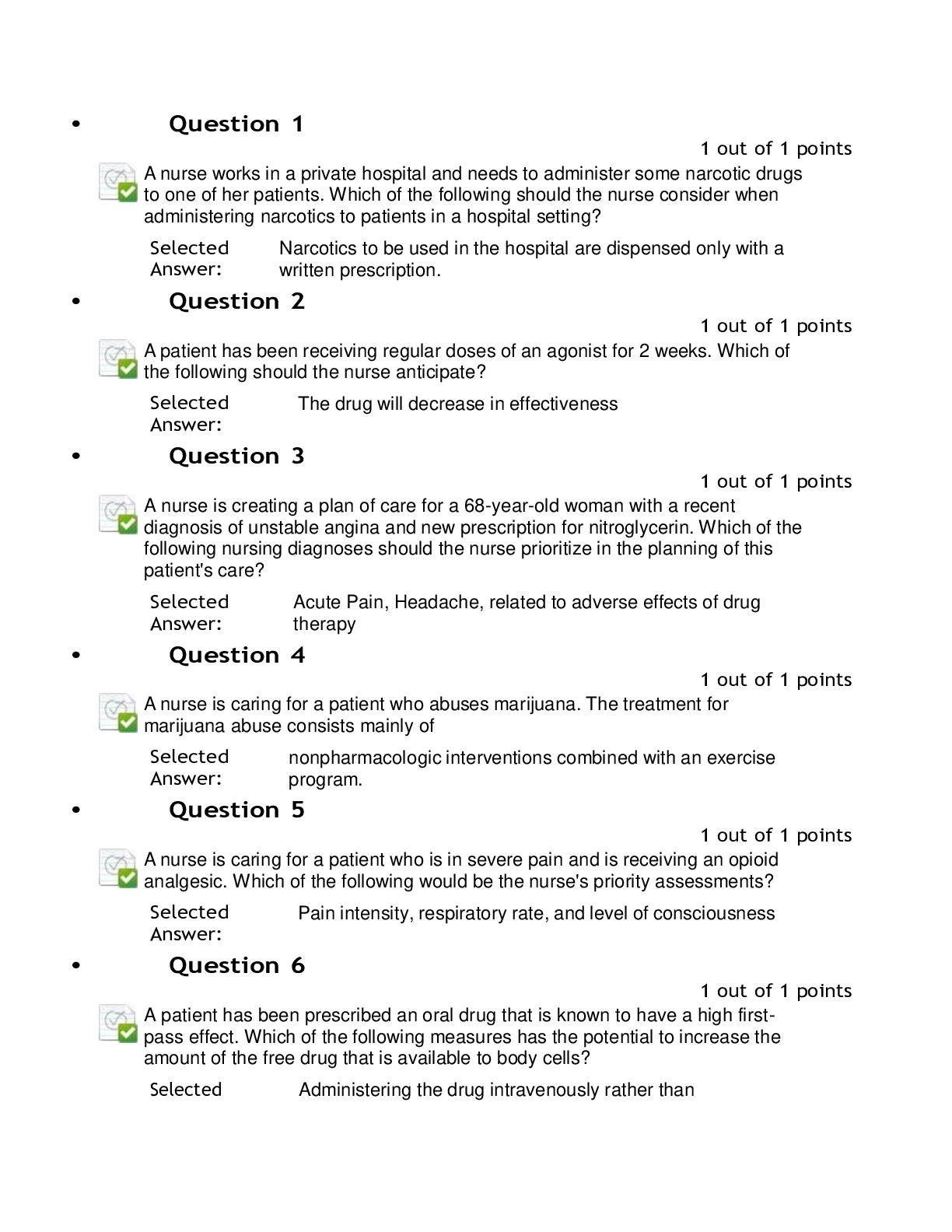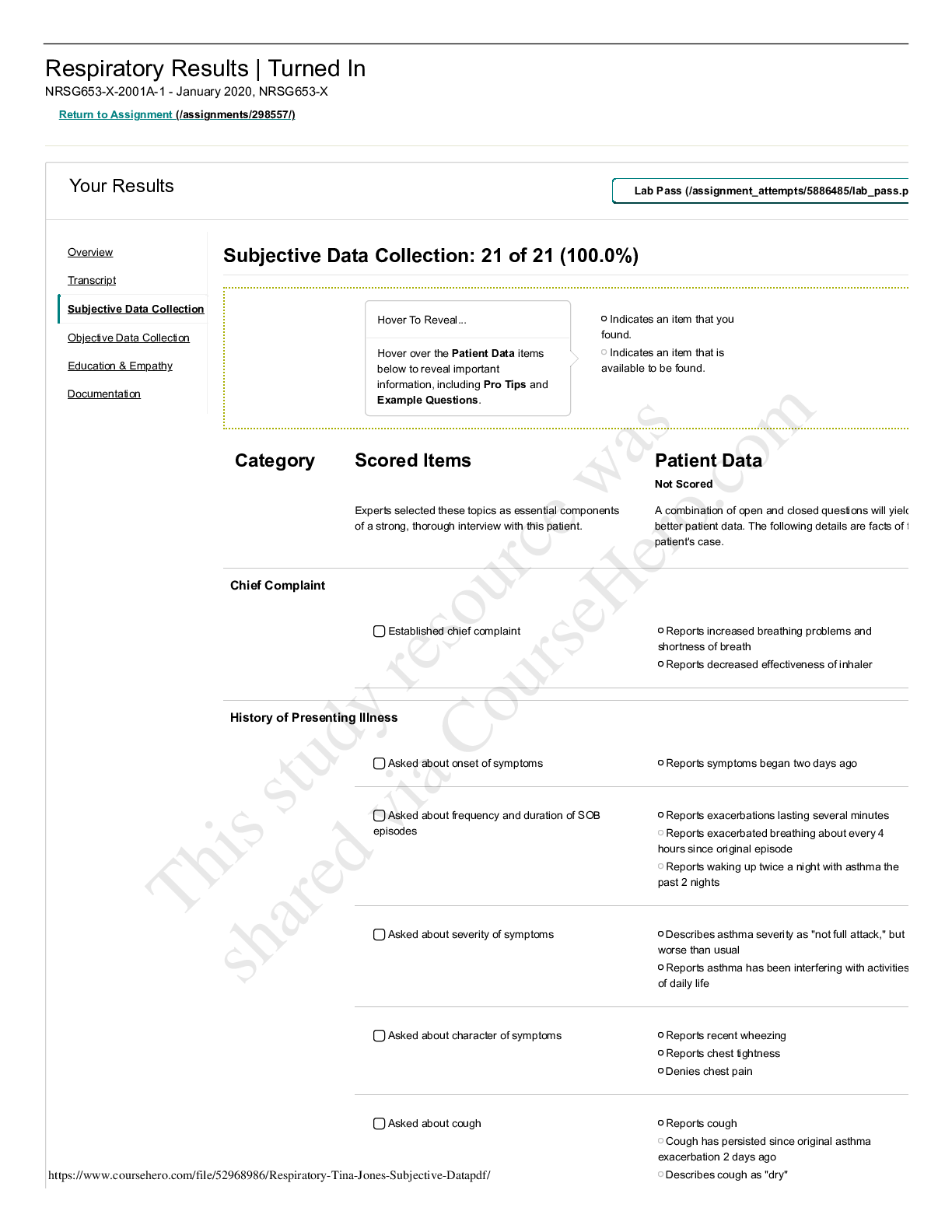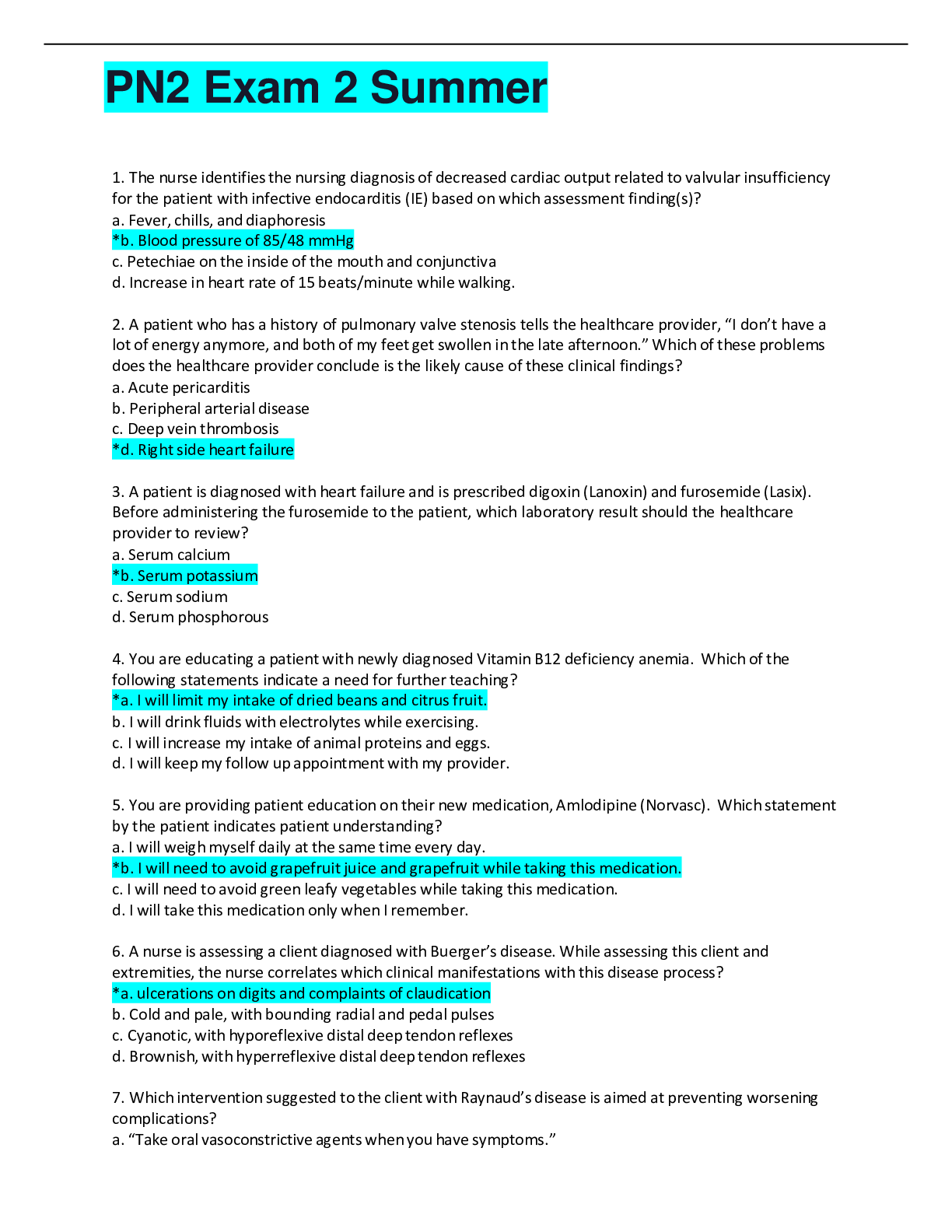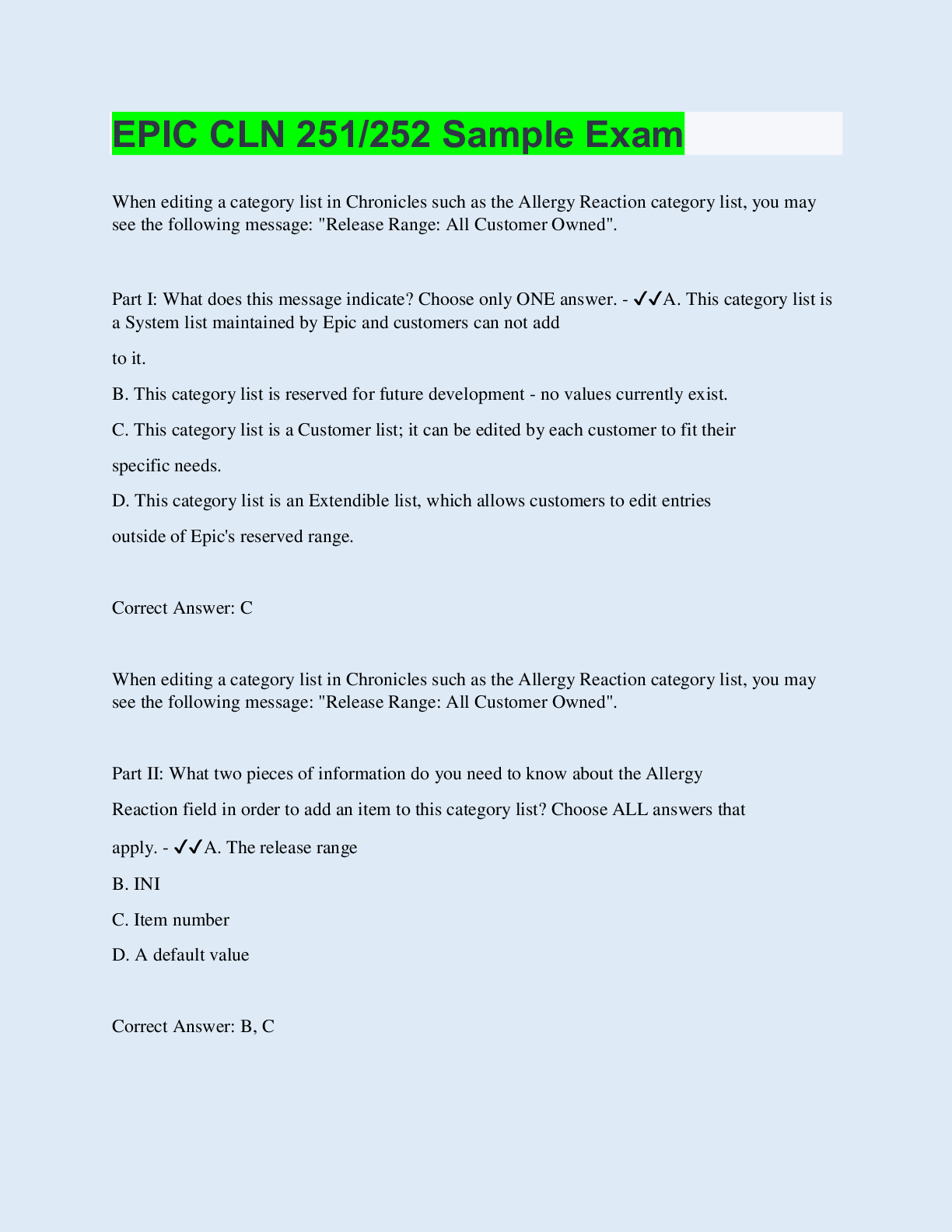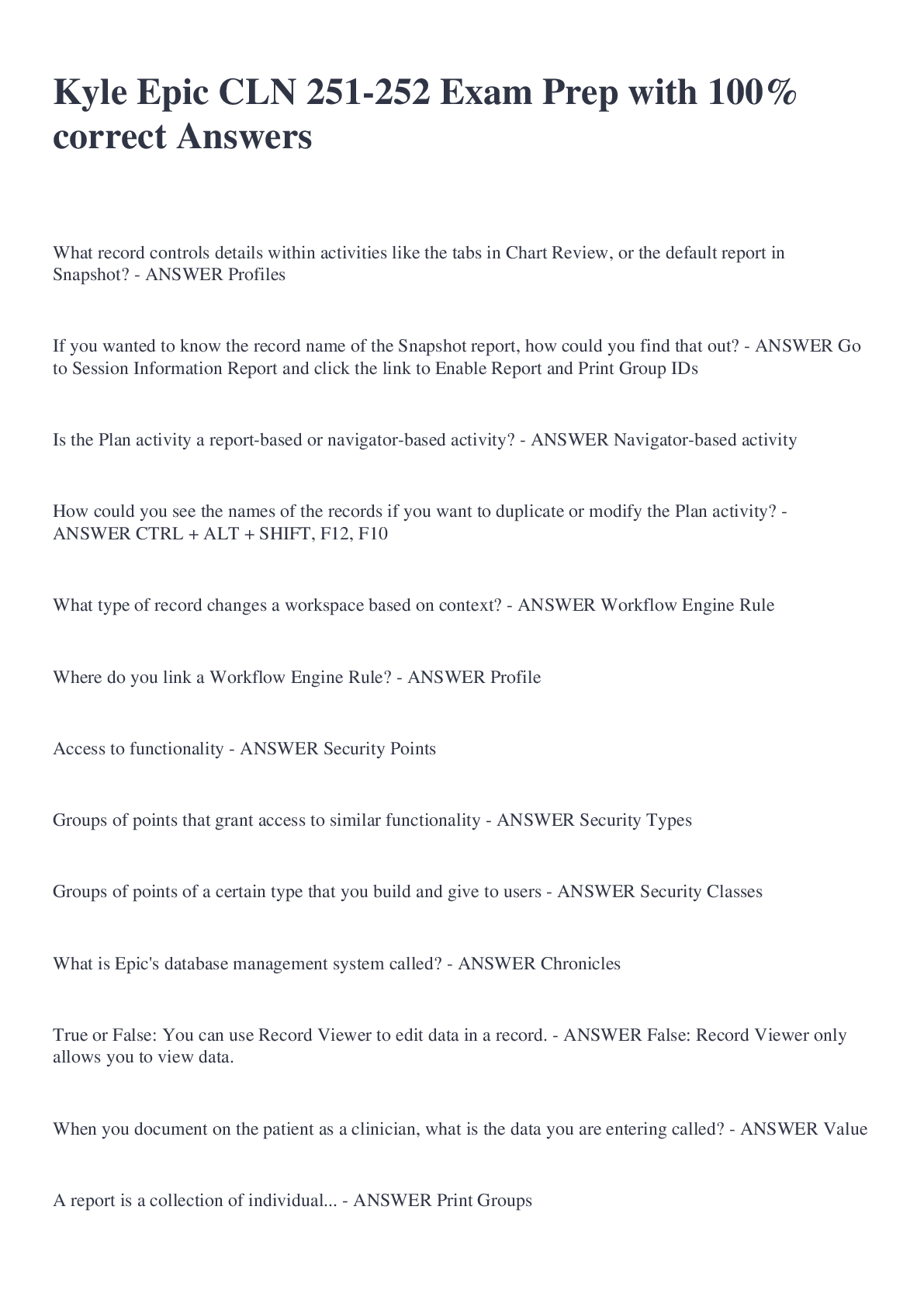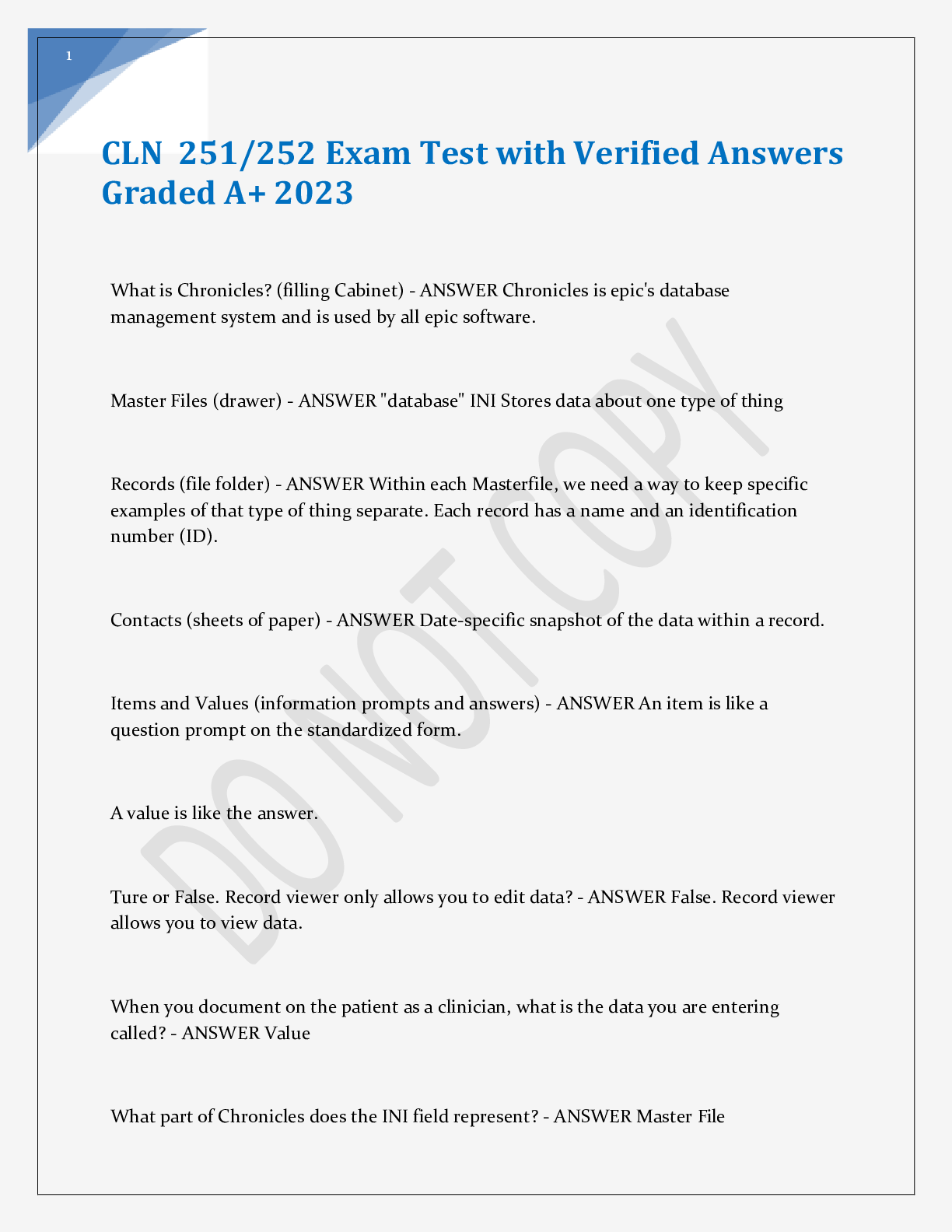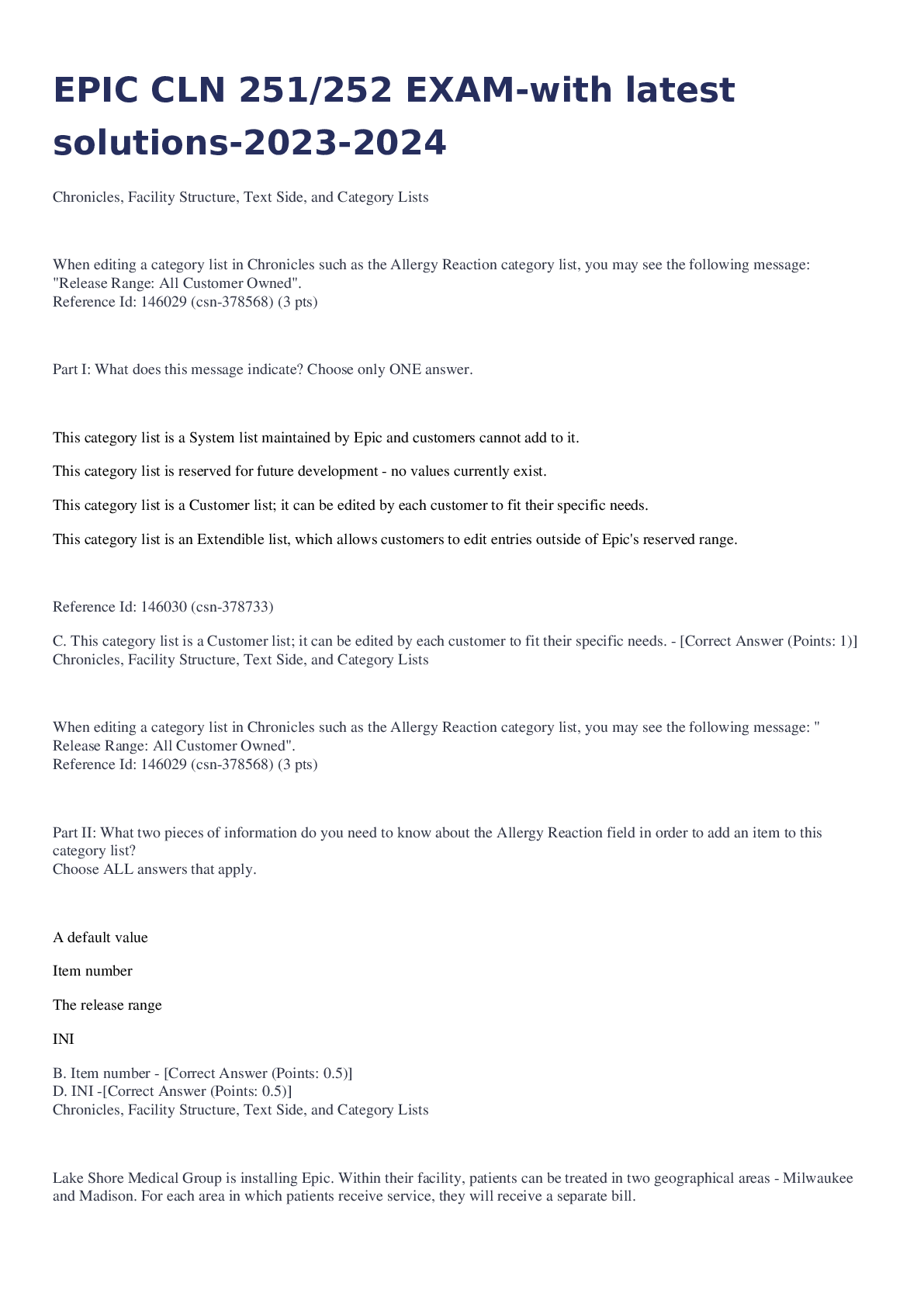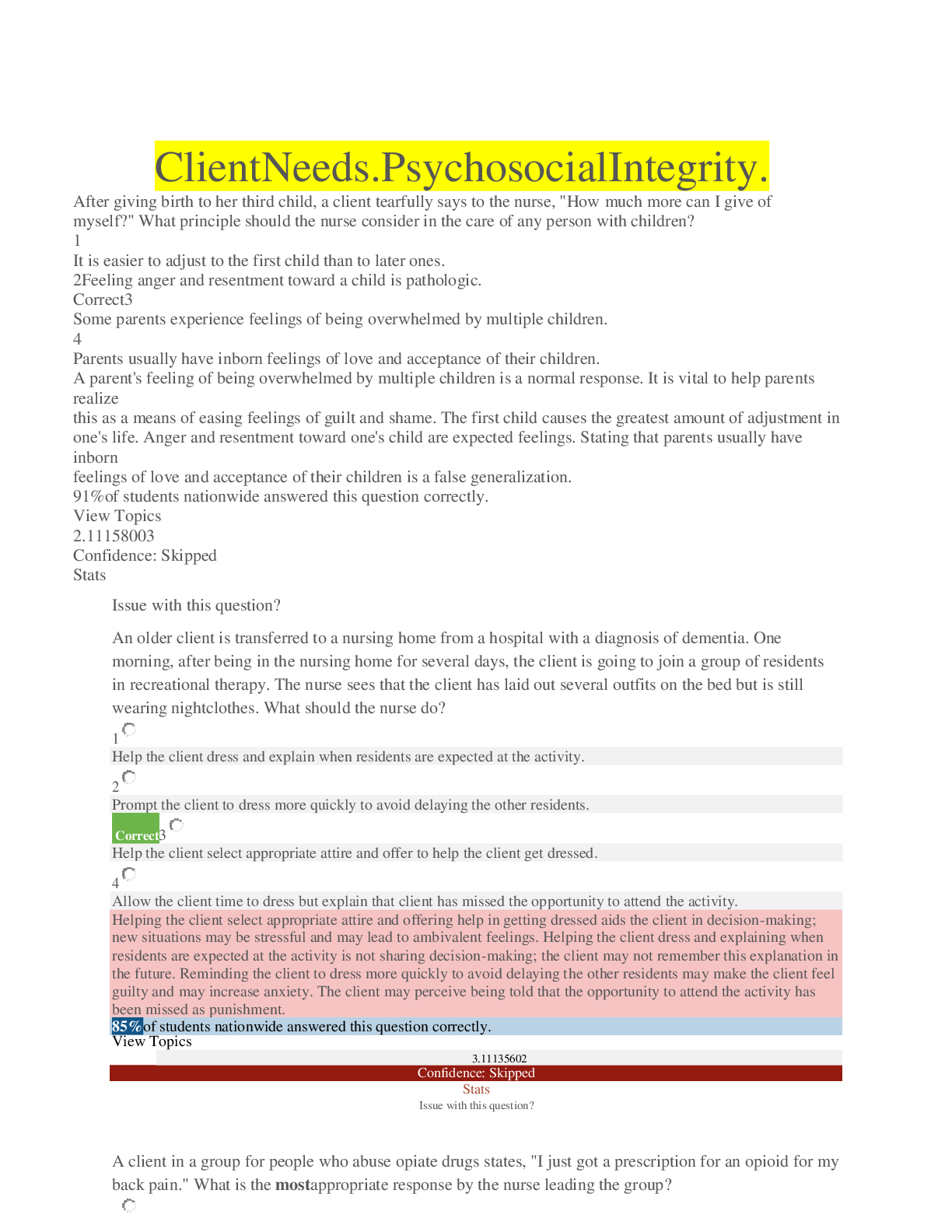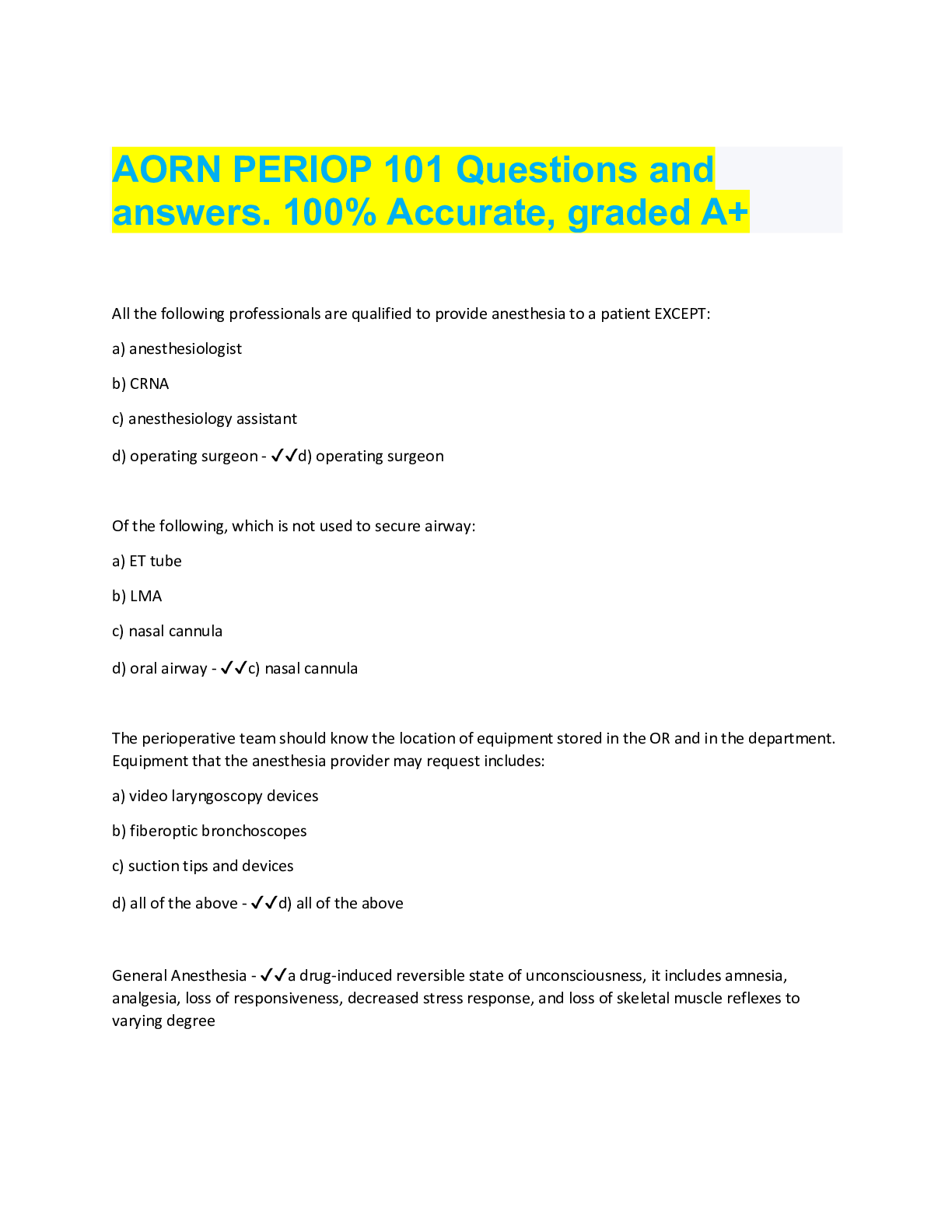NURSING 6501. Graded 100%..
Document Content and Description Below
NURSING 6501 • Question 1 2 out of 2 points Pulsus paradoxus greater than 20 mm Hg, tachycardia greater than 130 beats per minute, and increasing dyspnea are signs of: Response Fee... dback: Status asthmaticus is a severe and prolonged asthma attack that resists usual therapeutic approaches. The patient experiences dyspnea, can only get out a few words between breaths, and has tachycardia often more than 130 beats per minute and pulsus paradoxus greater than 20 mm Hg. Pulsus paradoxus is more likely in pericardial effusion, constrictive pericarditis, and severe asthma. • Question 2 2 out of 2 points What is considered the gold standard diagnostic radiology test for appendicitis? • Question 3 0 out of 2 points Your 85-year-old patient is complaining of right knee pain. She has a history of osteoarthritis for which she is given antiinflammatory medication. To assess her right knee pain, you should ask her if: Response Feedback: It is most appropriate to ask a present tense evaluation question, such as whether the patient took her pain medication; the question should be simply worded without the addition of multiple factors to consider. You should refrain from asking older patients to compare past with present symptoms, because recollection may be uncertain and recollection of past pain is sometimes not readily achieved. Systematic evaluation of the right knee should be completed before any additional symptoms are evaluated. Knowing that the pain gets better when she sits does not help assess the right knee pain. • Question 4 2 out of 2 points Ms. Green is an 85-year-old female patient with dementia who presents to the emergency department with her daughter because of a change in function. Which pain assessment scale would be the best choice? Response Feedback: The Checklist for Nonverbal Pain Indicators is for nonverbal adults. The Oucher and Wong/Baker Rating Scales are pediatric scales. The CRIES Scale is for infants. • Question 5 2 out of 2 points You are caring for a patient with trigeminal neuralgia. During the assessment, the patient would describe the pain as: Response Feedback: Pain resulting from nerve tissue damage is described as having a burning, shock-like (electrical) quality. Throbbing and dull pain is usually due to a tumor pressing on a cavity. Tender and deep pain results from bone or soft tissue. Cramping and spasmodic pain is usually visceral or colic pain. • Question 6 2 out of 2 points A 5-year-old is complaining of nondescriptive "belly pain." Your next action should be to ask him to: Response Feedback: Asking the child to point to the area of pain can help communicate a more precise location. • Question 7 2 out of 2 points A patient presents to the emergency department after a motor vehicle accident. The patient sustained blunt trauma to the abdomen and complains of pain in the upper left quadrant that radiates to the left shoulder. What organ is most likely injured? Response Feedback: Spleen laceration/rupture is always suspected with abdominal injury, because of its anatomic location. The patient s presenting symptoms confirm this suspicion. • Question 8 2 out of 2 points Percussion at the right midclavicular line, below the umbilicus, and continuing upward is the correct technique for locating the: Response Feedback: Percussing along the right midclavicular line upward from the umbilicus determines the lower border of the liver. A liver border more than 2 to 3 cm signifies hepatomegaly. • Question 9 2 out of 2 points An examiner can recognize a friction rub in the liver by a sound that is: Response Feedback: An abdominal friction rub is rare and can be identified when high-pitched sounds are auscultated in association with respirations. • Question 10 2 out of 2 points When palpating the aorta, a prominent lateral pulsation suggests: Response Feedback: Anterior pulsations of the aorta are within normal limits; lateral pulsations suggest an aortic aneurysm. • Question 11 2 out of 2 points In order to assess for liver enlargement in the obese person, you should: Response Feedback: If the abdomen is obese or distended, or if the abdominal muscles are tight, you should plan on auscultating the liver using the scratch method to estimate the lower border of the liver. Cutaneous hypersensitivity is a sign of peritonitis and does not contribute to determining liver size. • Question 12 2 out of 2 points When examining a patient with tense abdominal musculature, a helpful technique is to have the patient: Response Feedback: To help relax the abdominal musculature, it is helpful to place a small pillow under the patient s head and under slightly flexed knees. The other choices increase muscle flexion. • Question 13 2 out of 2 points Your patient presents with symptoms that lead you to suspect acute appendicitis. Which assessment finding is least likely to be associated with this condition early in its course? Response Feedback: Psoas sign, McBurney point pain, rebound tenderness, and periumbilical pain that migrates to the right lower quadrant are signs of appendicitis. Conditions that cause irritation of the obturator muscle are late findings usually associated with a ruptured appendix or pelvic abscess. • Question 14 2 out of 2 points When auscultating the abdomen, which finding would indicate collateral circulation between the portal and systemic venous systems? Response Feedback: Venous hum is associated with blood flow in venous collaterals found in portal hypertension. Aortic bruit occurs during systole, while a venous hum is a continuous sound and softer than a bruit. The other choices are not vascular sounds. • Question 15 2 out of 2 points Infants born weighing less than 1500 g are at higher risk for: Response Feedback: Necrotizing enterocolitis is a gastrointestinal disease that mostly affects premature infants; it involves infection and inflammation that causes destruction of the bowel, and it becomes more apparent after feedings. Low birth weight does not relate to the development of hepatitis A, urinary urgency, cystic fibrosis, or pancreatitis. • Question 16 2 out of 2 points Which organ(s) are located in the retroperitoneal space? Response Feedback: The kidneys are located in the retroperitoneal space, lying behind the abdominal cavity and beside the abdominal aorta. • Question 17 2 out of 2 points In older adults, overflow fecal incontinence is commonly due to: Response Feedback: Constipation with overflow occurs when the rectum contains hard stool and soft feces above leak around the mass of stool. • Question 18 2 out of 2 points A 45-year-old man relates a several-week history of severe intermittent abdominal burning sensations. He relates that the pain is relieved with small amounts of food. Before starting the physical examination, you review his laboratory work, anticipating a(n): Response Feedback: The patient s presenting symptoms suggest peptic ulcer disease. The supporting laboratory finding is the presence of H. pylori. • Question 19 2 out of 2 points An umbilical assessment in the newborn that is of concern is: Response Feedback: What is expected is two arteries and one vein. A single umbilical artery indicates the possibility of congenital anomalies. A thick cord suggests a well-nourished fetus, an umbilical hernia will generally spontaneously close by 2 years, and pulsations to the abdomen in the epigastric area are common. Nondistended superficial veins are usually visible in the thin infant. • Question 20 2 out of 2 points A 1-month-old boy has been vomiting for 2 weeks. How is this symptom of gastroesophageal reflux disease (GERD) and pyloric stenosis further differentiated in this child s assessment? Response Feedback: With pyloric stenosis, vomiting becomes projectile and a small olive-sized mass is palpable in the RUQ; the infant is usually hungry again soon after vomiting, and because little or no food is reaching the intestines, the infant has fewer, smaller stools. The child fails to thrive and has signs of dehydration. These signs are not associated with GERD. Regurgitation can be present with either disease. [Show More]
Last updated: 1 year ago
Preview 1 out of 6 pages
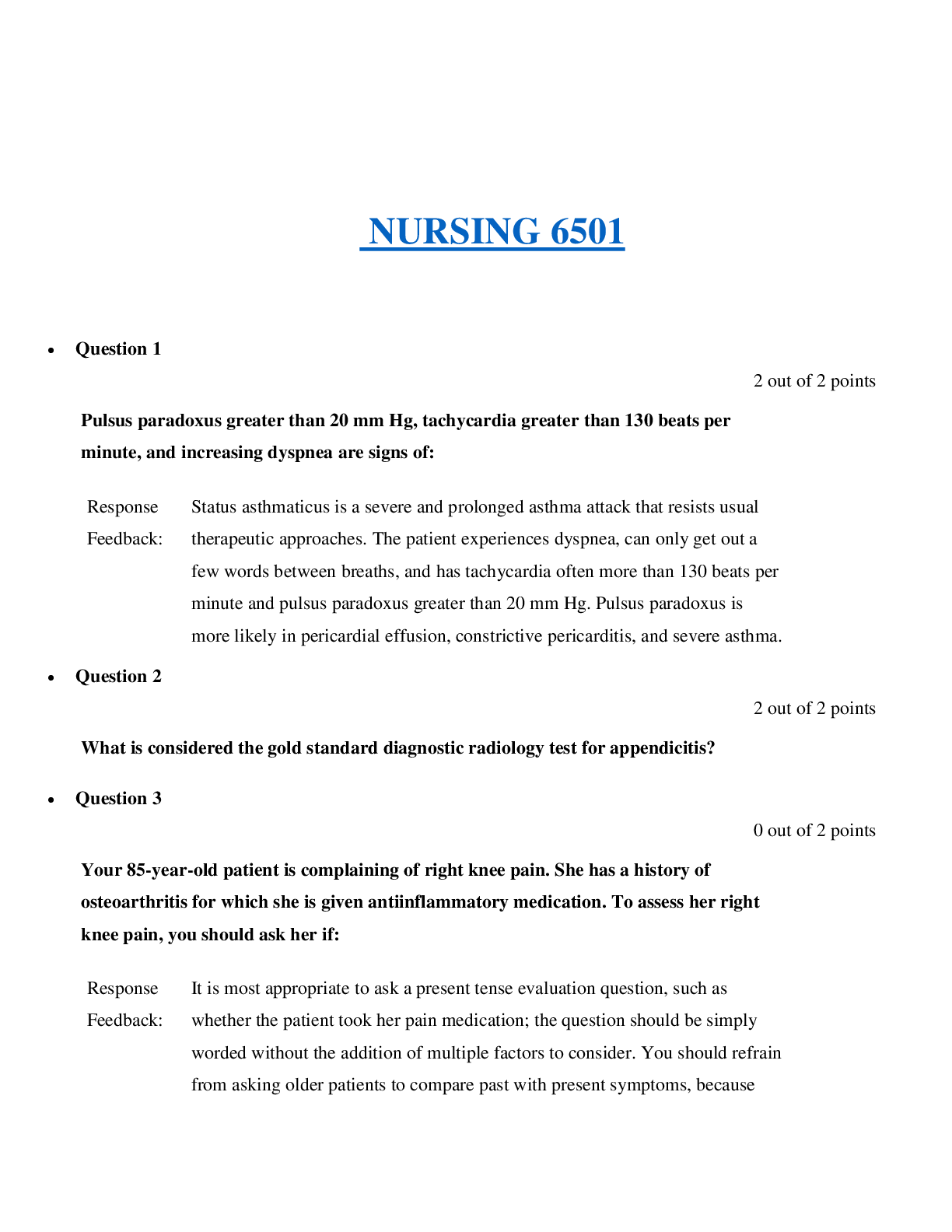
Reviews( 0 )
Document information
Connected school, study & course
About the document
Uploaded On
Aug 09, 2019
Number of pages
6
Written in
Additional information
This document has been written for:
Uploaded
Aug 09, 2019
Downloads
0
Views
72


